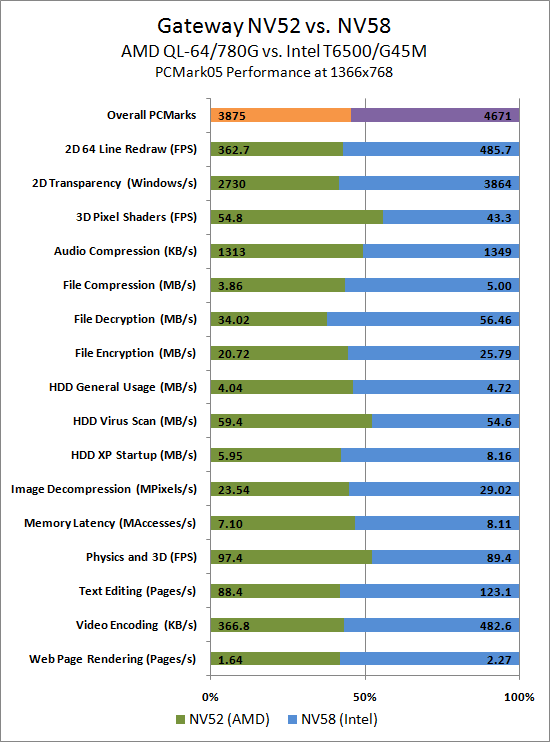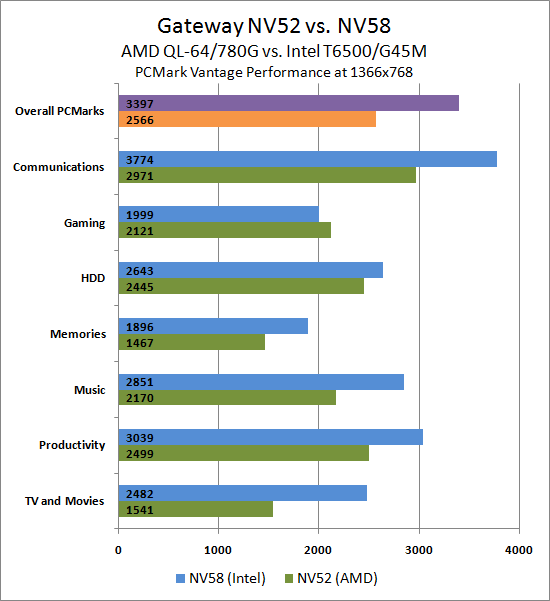Gateway AMD and Intel Laptops, a Platform Analysis
by Jarred Walton on August 12, 2009 2:00 AM EST- Posted in
- Laptops
PCMark Performance - AMD vs. Intel
Futuremark's method of determining composite scores in PCMark (and 3DMark) can be something of a mystery. Rather than taking the results at face value, we felt it would be more beneficial to show the individual scores for the various tests. We'll start with PCMark05, which is somewhat outdated relative to current software but also provides a more realistic look at how many people continue to use their computers (i.e. most people continue to use single-threaded applications more than multi-threaded applications).

In PCMark05, the Intel system ends up 20.5% faster in the overall metric, but individual scores range from Intel leading by 66% (File Encryption) to AMD leading by 26% (3D Pixel Shaders). A couple other important metrics are Web Page Rendering, HDD XP Startup, and HDD General Usage. These are all common situations that you encounter any time you use a computer, and Intel leads by 38%, 37%, and 17% in these tests, respectively. During testing, it was obvious that the Intel system was substantially faster in general use. Booting both systems, it would always finish loading Windows noticeably faster, and when we ran a disk defragment on both systems after installing all of the test software the AMD system took hours longer to finish.
It should be clear why the AMD system wins in the Physics and 3D (9%) and 3D Pixel Shaders (26%) tests. What's not so clear is why AMD would win in the HDD Virus Scan (8%) result, and the likely culprit is the Seagate hard drive is faster than the Hitachi HDD in the NV58 in this specific test. It's also important to remember that individual scores can fluctuate quite a bit between runs on PCMark05 - up to 12% between the various runs we conducted on these two laptops. The overall scores on the other hand remain relatively consistent. Let's move on to PCMark Vantage and see if the picture changes at all.

This time the Intel system is 32% faster in the composite score, with individual scores ranging from 6% in AMD's favor to 61% in Intel's favor. Again, AMD takes the Gaming crown, although as we shall see shortly the 6% margin of victory is highly suspect when we get to actual games. Outside of the HDD test - a test that logically focuses more on the hard drive than the rest of the system - Intel maintains a comfortable lead of 20% or more.
The short story to this point is that not only does the Intel system provide substantially better battery life, it also provides a much snappier user experience. If all you're looking for is a typical office computer, the extra $80 you spend for the NV58 is definitely a worthwhile investment compared to the NV52. There is still the question of graphics, of course, so let's look at the last area and consider how much gaming performance matters in your laptop purchasing decision.
Update
Here's an alternate chart for PCMark Vantage showing relative performance. Given the disparity in scores for PCMark05, we didn't bother creating this style of chart.











67 Comments
View All Comments
strikeback03 - Thursday, August 13, 2009 - link
"Again, what percentage of laptop users actually play 3D games on a regular basis - or at all?"Doesn't mean that no users play 3D games, it means that the majority never do, some small percentage play infrequently, and some smaller percentage would regularly.
Also, an AMD blog is probably not the best place to look for a balanced view of an AMD/Intel comparison.
flipmode - Wednesday, August 12, 2009 - link
AMD's mobile products have always been rebranded desktop products - which have always been rebranded server products. In the best cases, the CPUs run at lower voltages and lower speeds.Intel has, interesting, done the opposite, as far as I can tell. They designed the Pentium M from the ground up for mobile, and turned that into Core 2 for the desktop, and turned that into Nahalem for the server.
This is all in spite of the fact that several years ago, AMD stated that it was placing mobile above desktop in terms of importance. But technology has a natural flow between the two poles of server and mobile, with desktop stuck in the middle. AMD chose to flow from high to low, Intel chose to flow from low to high. It seems that Intel's choice was the better one.
blackshard - Wednesday, August 12, 2009 - link
Approximately it is true, but consider that these 65nm mobile AMD parts have absolutely no correspondence in desktop market. These are Family 11h processors and are a mixture of old K8 (execution units) and newer K10 processors (memory controller, power management).Actually Athlon QLs is the least attractive from a performance and power management point of view. I hope Walton will get some ZM/RM processors from AMD to make a clear comparison.
mircix - Wednesday, August 12, 2009 - link
Ok. Great article and I have a simple question. I am interested mostly in Avid, witch is a professional video editing software, and 3ds max. 3ds for movie CGI. I'm not looking for a desktop's working station performace, but something decent. I've runned 3ds 2009 on a 1.6 gh and intel gms 950, hp pavilion dv100 and works. but slow. So, for closure: 3ds max and Avid : AMD or Intel? Thank youjamawass - Wednesday, August 12, 2009 - link
Although the conclusions of the article are correct, the graphical charts for gaming comparisons are sneakily designed to minimize the tremendous advantage AMD has in gaming performance over Intel. If this performance is as unimportant as the author states ( Kia vs Hyundai) why not represent it in bar chart form like all the other results? As another poster said, testing games like the Sims or WoW would be much more meaningful on these platforms than FPS.I don't think anyone buys a laptop of this price for gaming but I've owned an AMD one like it and on overseas trips I would take FarCry along and fire it up for some casual gaming something I wouldn't be able to do on a similarly spec'd Intel laptop.
We know Intel has the superior mobile design but objectivity would be nice so independent decisions can be made as to how important gaming is to a potential buyer.
IHateMyJob2004 - Wednesday, August 12, 2009 - link
I really want a laptop for wordprocessing. All I want is a cheaper (processing power not needed) laptop with a high resolution. 1920x1200 is what I want but this also seem to be a segment that Every manufacturer is ignoring. This is how a utilitarian wants to use alaptop and I'm sure I am not the only one out there.And I agree with what you said. Unelss the primary use for a laptop is games and movie watching, the 16:9 and 16:10 ratio screen is stupid. Widescrees are in, but I view them as short screens. And short screen suck for word processing and software develeopment. Give me a 5:3 ratio screen! Bring them back!
The only thing I am really curious about in terms of performance is how much better a low cost laptop is if it has a dedicated viddeo card with its own memory versus a laptop where the video card uses system memory. I'm mostly concerned with any lag that is associated with the video card due to how it uses memory.
strikeback03 - Thursday, August 13, 2009 - link
See, plenty of people like the widescreens for writing tasks, as you can have 2 800px columns of text on a 1920px screen side by side. I don't like the current move to 16:9 from 16:10 though, that is obviously a step back.mczak - Wednesday, August 12, 2009 - link
This article clearly shows that AMD desperately needs updated mobile platform (Tigris). In terms of chipset won't be much of an update (rs880m/sb710) but finally 45nm cpu (Caspian - probably same as regor for mobile market). Won't be enough to close the gap (those 65nm Athlons didn't do too well against 65nm C2D neither) but at least something more competitive (so together with the price advantage and better graphics maybe a competitive package).mczak - Wednesday, August 12, 2009 - link
forgot to mention, that platform better show up soon. Against Intel's Calpella platform (with Arrendale cpu) it will look quite bad I assume, and even the graphics advantage could disappear. Fortunately for AMD, Arrendale shouldn't show up before 2010, though that's not that much time left...weeaboo - Wednesday, August 12, 2009 - link
I don't play it personally, but I imagine that one of the most common game people play on their non-gaming laptop is World of Warcraft. On this kind of platform I think performance figures on the MMOs of yesteryear would be more interesting than a plethora of FPS games.